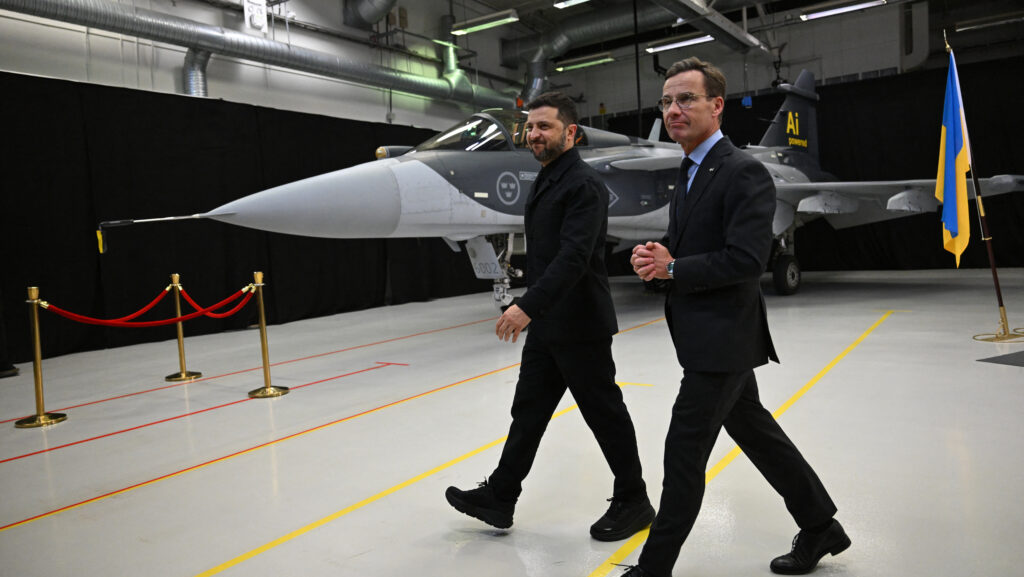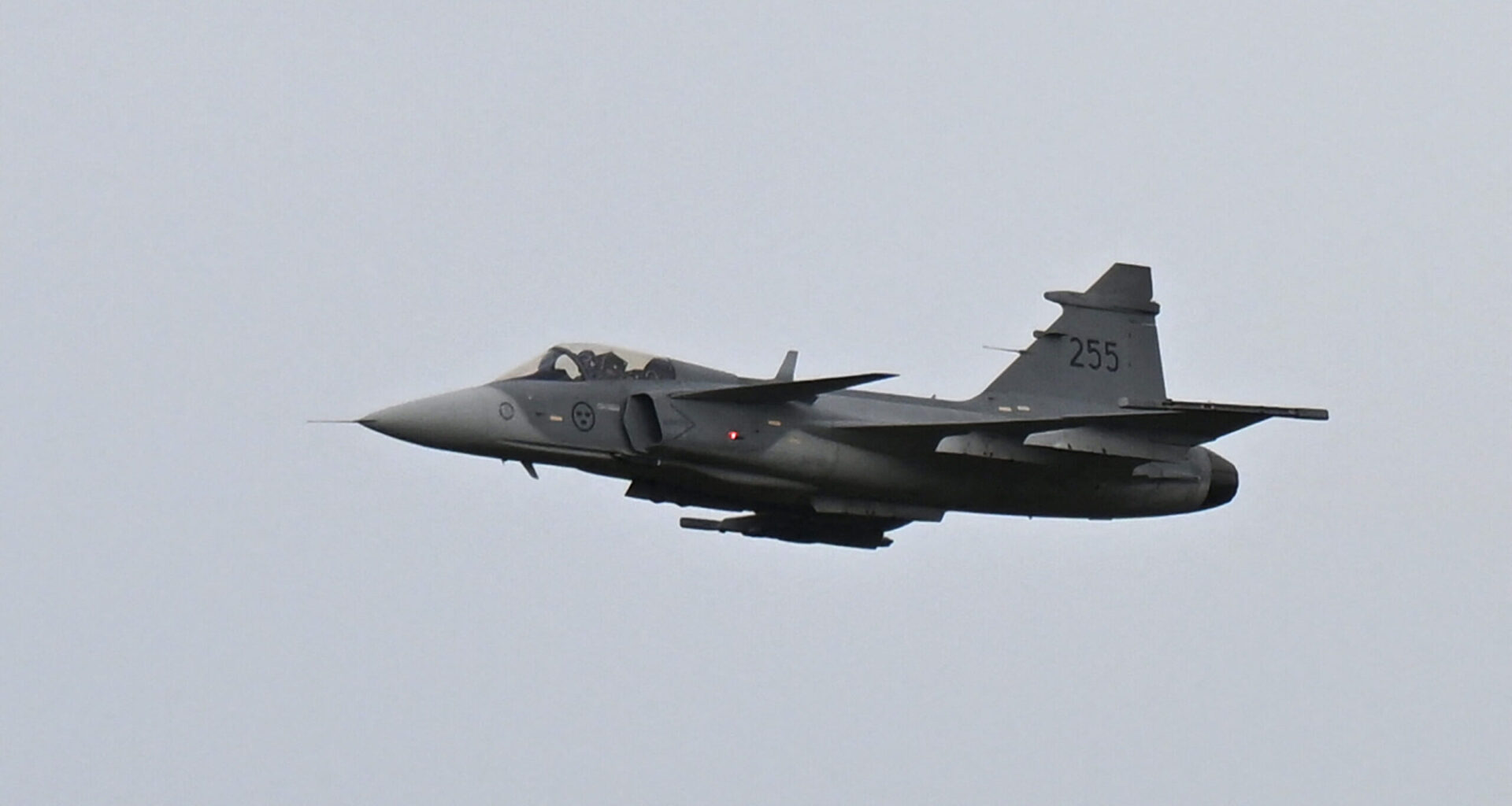WARSAW — This week’s announcement that Ukraine’s Air Force (PSU) would acquire between 120 and 150 of the Swedish-made Saab JAS-39E Gripen fighters came as a shock. After all, just a month ago, Sweden’s defense minister was saying any agreement would be a “long-term” situation to work out.
Still, despite the excitement around the agreement, it will take several years before Gripen is flying over Ukrainian airspace. And there are plenty of questions about what comes next.
For instance: Why did the PSU decide on Gripen, when the service is currently flying French and US jets? What is it about the aircraft that makes it a better fit for Ukraine’s requirements. And what kind of teething pains might be expected with the Gripen as it enters Ukraine’s arsenal?
The PSU now have a good deal of experience in operating western-design fighters, but they have been older F-16 and Mirage 2000 models that were developed and built during the Cold War era. They lack the key technological characteristics seen in current-day designs, like an Active Electronically-Scanning Array (AESA) radar.
Since this will be the first fighter with a state-of-the-art set of on-board systems, characterized by a digital infrastructure. It will have the ability to operate in contested air combat environments and with a complement of advanced weapon systems. But there will be challenges incorporating it into PSU service.
“Taking on these old F-16s and Mirages is one thing,” said a Ukrainian defense enterprise executive whose company is supporting these aircraft for the PSU. “There are many people around who have flown them, know how to service them, and they are a known quantity after having participated in so many combat zones around the world.”
“The Gripen E is obviously a marvel of a machine and no one is really completely familiar with how it performs in combat,” he told Breaking Defense. “We will have to learn how to use it and how to get the most out of it. But in the end Ukraine will have a dramatically improved level of air power projection — the likes of which the no one had seen in this part of the world before.”
The Air War in Ukraine
To understand why Gripen may be a fit for Ukraine, it’s helpful to understand what the air war has looked like since Moscow’s February 2022 invasion began.
As the war kicked off, the priority for the Russian Aerospace Forces (VKS) was to perform the Suppression of Enemy Air Defenses (SEAD) mission. This was because the initial Moscow battle plan was to use airborne assaults to take control of Kyiv in a nighttime surprise operation and decapitate the Ukrainian government.
But it didn’t take long for the plan to unravel. Moscow was quickly proven to be unable of defeating Ukraine’s air forces, and the losses inflicted by Ukraine caused the initial pullback by the VKS around March 3, 2022. This was about the time Ukraine’s ground-based air defense units had regrouped from Russia’s unsuccessful SEAD efforts.
From this point forward, the VKS became progressively less effective. By early April of that year, the force had shut down most attempts at penetrating Ukrainian airspace.
Philip Breedlove, the former SHAPE Commander and fighter pilot with more than 3,000 said at the October 2022 Warsaw Security Forum that the Russian air campaign was hobbled by organizational and training shortfalls and a lack of a functional command structure.
For years “we had assumed Russia still had the skill to perform the SEAD mission: to locate, track and neutralize these surface-to-air missile installations,” he said in a presentation then. “This is a skill set that air forces — particularly the USAF — practice every day. If the Russians ever had this capability, they have forgotten about how to do this.”
Since this time the VKS has been engaged in a campaign of terrorizing the population by attacking civilian targets — largely Ukrainian cities and energy grids. Russian aircraft — especially its strategic bomber component — have been operating almost always over Russian territory. Air-to-air engagements are rare.
As for the PSU, they have relied heavily on dispersed basing operations. The ability to evacuate squadrons from fixed air bases and then launch and recover aircraft from highways and other unimproved airstrips was a predominant feature of Soviet air power doctrine.
Unlike some other nations after the fall of the USSR, Ukraine never abandoned this Soviet military concept. So when Russia attacked, the PSU immediately transitioned into dispersed operations and implemented what has been labelled as an “agile based strategy.” This meant having the PSU’s aircraft and pilots rotating between a larger number of airfields in western Ukraine so that they would not be in any one location long enough to be targeted.
These operations, which are still ongoing, reportedly require strict operational discipline. Pilots were never allowed to take off and land at the same airfield in a single sortie. Photos of pre-war training by the PSU clearly show that Ukrainian pilots had also been regularly training how to utilize roads as temporary airstrips.
 Swedish Prime Minister Ulf Kristersson (R) and Ukrainian President Volodymyr Zelenskyy walk past a Gripen fighter jet after they delivered a joint press conference in Linkoping, Sweden, on October 22, 2025. (Photo by JONATHAN NACKSTRAND/AFP via Getty Images)
Swedish Prime Minister Ulf Kristersson (R) and Ukrainian President Volodymyr Zelenskyy walk past a Gripen fighter jet after they delivered a joint press conference in Linkoping, Sweden, on October 22, 2025. (Photo by JONATHAN NACKSTRAND/AFP via Getty Images)
The Appeal Of The Gripen
That operational requirement may tie into the decision to choose the Gripen. Because while other fighters have the ability to perform dispersed operations — and the Ukrainians have had to do so with the older F-16s in their arsenal — the Gripen, designed by Swedish firm Saab, is the only western fighter designed specifically for dispersed operations. The Gripen E also reportedly achieves 85 percent availability or better with optimal levels of support
Cost likely also played a factor. Being smaller and not having two engines like a Eurofighter, Rafale or F-15, the Gripen is simply less expensive to procure. But its cost per flying hour is also lower — simplicity of design, the ability to support the aircraft and maintain it from the back of a truck during dispersed operations make for a fighter that has a public cost per flight hour of $8,000, although Saab officials over the years have said that can come down depending on how the plane is used.
Sweden’s government today is promising the first Gripens for Ukraine would be delivered within three years. That’s likely a faster timeline than other competitors, and time, obviously, is of importance for the Ukrainian forces.
Another aspect that may have appealed to Ukraine is the fact the Gripen-E is designed with electronic warfare in mind — and the battle for Ukraine has been defined as much by EW as it has kinetic attacks.
“The Gripen E’s new EW system uses three types of signal generators to either try to obscure the existence of the aircraft or cause confusion about its location and/or existence so that an adversary cannot choose a proper firing solution. These three types of signal generators are Digital Radio Frequency Memory (DRFM), Doppler, and Noise,” explained one of the company’s EW specialists during a 2018 conversation.
“DRFM emulates the signal of the radar that makes contact with the aircraft and then mirrors it back so that it appears to the radar operator on the other side as an empty return and that the radar encountered nothing. The Doppler generator attempts to create false targets so that a radar, and the missile it provides a firing solution for, cannot lock onto a target because it is constantly shifting position,” he continued.
“By causing the target to appear to move, a radar operator can lose situational awareness or a missile runs out of energy because it is constantly changing vectors to try and continue to track a shifting target. The noise generator creates clutter and background noise, which prevents a radar from initiating a proper target lock.”
The Challenges of a New Fighter
But the EW capabilities may be a double-edged sword, as Ukraine has never had anything nearly as capable as the Gripen-E to manage. These will be completely different types of missions. Pilots will have to learn how to effectively use the Gripen E’s sophisticated EW suite, which will require the creation of another new training regime.
Hand-in-hand with this issue is the AESA radar that is fitted to every Gripen-E aircraft — a major step up in capability from what the PSU has had, but one which can require a re-think of combat tactics and a potentially steep learning curve.
And new technologies are just challenge that is on the horizon.
Any air force taking on a new fighter is going to have no end of transition woes. New aircraft not only means developing new operational parameters, but the air bases themselves have to be physically reconfigured for the new jet — down to new bunkers to bed down the fighters.
“You have to do more than just paint all the rocks on the airfield white,” Phil Karber, a former Pentagon official who has advised the militaries of more than one Ukrainian government, told Breaking Defense. “New aircraft take a good deal of effort to get to the point where the ‘kinks’ are worked out.”
Training is another challenge for bringing a new plane type into service. However, the PSU has a leg up in that area, thanks to a decision from 2023 to start training Ukrainian pilots on the Gripen in hopes of one day procuring the jet. Yurii Ihnat, the head of communications for the PSU, was quoted in local media as stating there is already a cadre of pilots comfortable with the Gripen.
In theory, that would mean that as soon as the Gripens start delivering, there will be pilots ready to use them, allowing other pilots to undergo training — roughly 20 weeks worth, based on how the Gripen was introduced to Brazil — without pulling the active pilot pool off missions.
Additionally, PSU planners will have to think about how the air war will change with the Gripen available. To date, the F-16s and Mirage 2000s the PSU operates have been largely engaged in air defense missions — taking down enemy ballistic missiles and drones.
But having the Gripen — and having a large number of them eventually — will give the PSU the ability to go more on the offensive. That would also require getting closer to Russian air defenses or, depending on the politics of it all, potentially even penetrating Russian air space. All of that represents a major new set of options for the PSU, which will also have to factor such thinking into the tactics and procedures developed with the new jet.
While Ukraine certainly would love to get the Gripen in service today, the three-year gap may end up serving it well insomuch as there will be time to sort the above questions out, as opposed to the crash-course when the F-16s became available. And with the Gripen-E only entering Sweden’s service a few days ago, there will be much to learn about the jet.
What is clear now, though: Ukraine’s air capabilities are poised for a massive jump forward.

